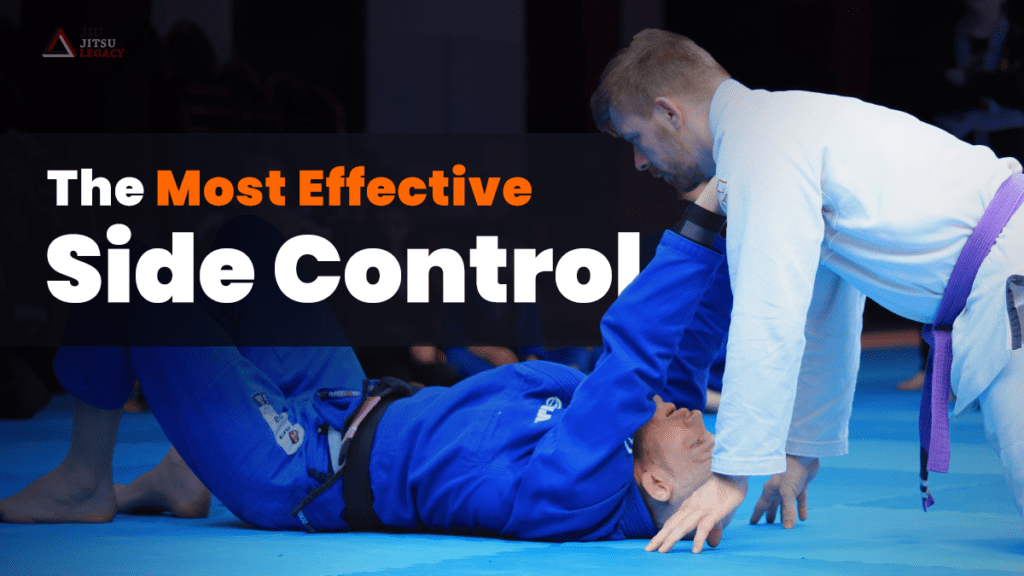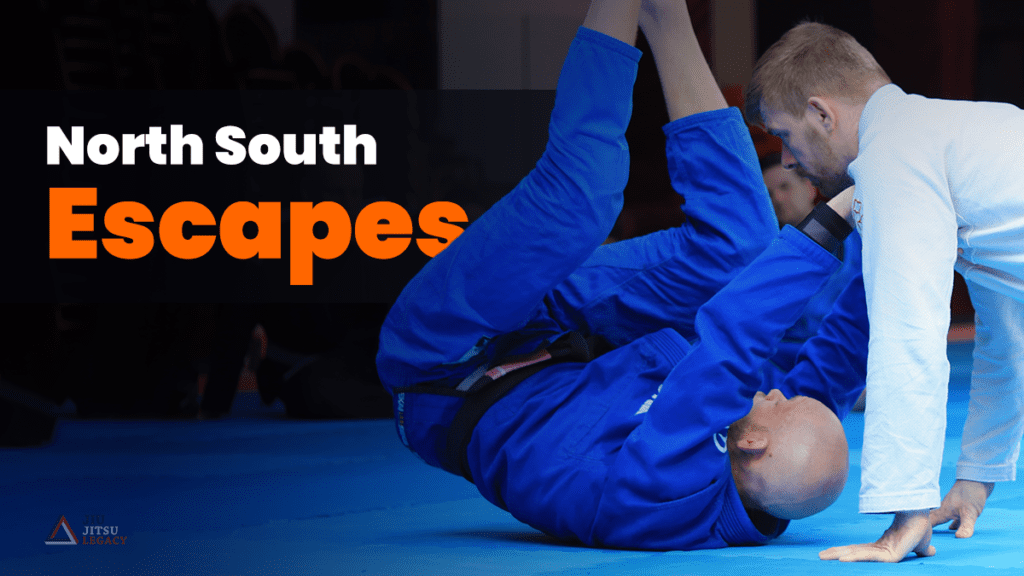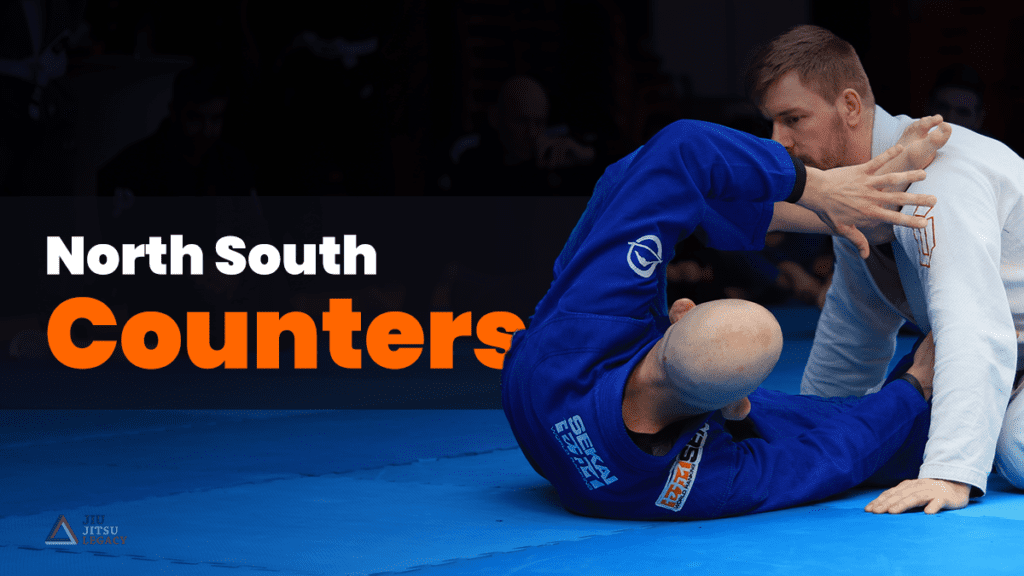The north south BJJ position is one of the most underrated top control positions in grappling. People usually tend to visit it only when hunting Kimuras, but it offers a lot more than that. When someone has you in a north south position, and they know what they’re doing, getting out can turn into a massive chore. Interestingly enough, not many people really have effective and logical north south escapes ready to go, so I hope that his article will provide you with at least a few.
The Most Effective Side Control Variation

The north south position is not a scoring position, as it is a variation of side control. It is, in my opinion, the most effective side control variation that you can play. There are several important reasons why this is the case.
First and foremost, escaping the north south BJJ position is so difficult because the top person’s hips are as far from the bottom person’s hips as it is possible without disengaging. This means that getting back to guard is going to be a daunting and tiresome task for the bottom person, in the very least. In most cases, attempts to get back into guard simply provide the top player with transitional or submission opportunities.
Moreover, the north south position means that the bottom person can only use their arms to try and create space, which is difficult and less than optimal. All the top person needs to do is to stay heavy and bide their time to move further up the position ladder. Or submit.
Last but not least, the north south position makes it extremely hard for the bottom person to breathe. Intentional or not, the top person can use their torso and upper arms to suffocate the bottom person, and it is perfectly legal to do so. While it won’t get a choke-type of tap, it accuses people to go into panic mode, which means they start to flail around opening up attacks.
So, how do you deal with such a position, and what are your options to get out of it?
Understanding the North South Position in Grappling
Before I move into the escape and counter portion, let’s try and understand what makes the north south BJJ position tick. After all, it is clear that the positioning means re-guarding is going to be a chore, but how does the top person manage to have so much control over the bottom player? I’ll go body part by body part in presenting the power of the north south position:
Arms
If you are on top, holding the north south position, both your arms can go in four different positions. You can have both your elbows in the opponent’s armpits, both your elbows over their shoulder, or a combined over-under control on either side. Each of these opens up different attacking opportunities and requires slightly different escape tactics.
The best part is that you can easily switch in between the positions, thus deterring many defensive movements and turning them into attacks without having to do all the heavy lifting.
Legs
The legs, along with the hips, of course, play a huge role in effective positioning in the north side BJJ position. In fact, I’d go as far as to claim that the way you position your legs in north south when on top defines how successful you will be with the position.
The key aspect is how you use your hips. An old-school wrestling classic, which dictates that you shouldn’t let your hips leave the ground (think of it as a perpetual sprawl) comes really handy here. Anything you do with your arms should be done with your hips to the ground.
The legs will follow your hip positioning. A great way to play north south is to which the leg position like you’re doing the jacare solo drill. That means keeping one leg fleshed at the knee at around a 90-degree angle, and the other one straight. This helps pin the head of the opponent and block their movement to one side completely.
Going into a turtle-like position with your legs means your hips will be high, and you’re more likely to lose the position, particularly if somebody inverts, or you do not have bot your elbows underneath their armpits. This type of positioning has its uses, but I’d go for the sprawl whenever you can. I’ll explain more when I discuss weight distribution shortly.
Torso
This is a big thing, and pretty much the one nobody pays attention to. In fact, torso positioning is just as important for the bottom person as it is for the top. Or now, let’s see the optimal positioning from the top of the north south BJJ position.
When in the top of north south, your torso should not be too far over the opponent’s torso. In fact, you should actually aim to keep your head off their chest slightly, trying to look forward instead of directly into the opponent. Moreover, you want to be slightly tilted so that your sternum is pressing on the side of their face, causing them to turn the head to one side.
Distribution of Weight
This is the last piece of the puzzle, and also the most important one. When you’re on the giving end of a north south BJJ position, you want to be as heavy as possible. Vice versa, when you’re on the bottom, it is going to be key to solve the weight distribution before attempting any north south escapes.
Given that you shouldn’t lift your hips off the ground too much, all the previous positioning I wrote about, in terms of arm, torso, and legs placement is optimally constructed so that you can be as heavy as a brick house when on top in the north south.
All you need to do is to lift everything except your toes off the mats, but only ever so slightly. Think about creating enough space so that a piece of paper can slide underneath you and not an inch more. If everything else is in place, you’ll be crushing your opponent along with any hopes they have of escaping without solving your weight distribution first.
North South BJJ Escapes
After making the north south BJJ position seem as if it is inescapable, let me point you to the light at the end of the tunnel. There is more than one way of dealing with the north south position and not just escaping but actually managing to pull off direct submission counters.
The long-winded explanation of north south mechanics above was absolutely crucial to understand the things that different parts of the body of your opponent are attempting to achieve. Without that, you’ll be picking the hard way out, which is battling until you cause a scramble, or until you give up mount or back, or worse, a submission.
Dealing with a strong controlling position like the north south has to happen in stages, and you have two main ones to consider: defense and escape. The order they come in is absolutely crucial to the success you will have.
To begin with, you need to mount a solid and difficult-to-break defense. That means conceding that the top person is in control of the north south position, and preventing them from using it to move you in a way that will open up other positional pins for them (mount/ knee on belly/back control) or isolate a limb or your neck so that they can submit you.
Only when you’re safe from further damage, you can see how you can reverse what has been done and get out of the position. At this point you can choose one of two available directions at a crossroad – you can escape, getting back to guard, back to your feet, or ending up in top position, or you can look to launch a direct counterattack, most often in the form of a submission hold from the bottom of north south. Your choice of direction will depend a lot on the situation you find yourself into.

Body Positioning
How you position your body from the bottom will define the success you have with your defense. As already covered, the torso positioning is crucial in whether you’ll be able to get out or not. Defense starts with body positioning, and there’s nothing more important than keeping both your shoulder blades off of the mats.
Tilting to one side will let the trick be done, and you don’t have to think too much about anything technical. Just make sure you’re lying on one shoulder blade. If you are aware of Priit Mihkelson’s escape system, then going into the Hawkings posture is all you need.
Your legs will need to follow the alignment of your torso. When you tilt to one side, you’ll get a top and a bottom leg. The bottom pone needs to be as close to the ground as possible, preferably with a bent knee (protecting your inside space).
The top leg should be with the foot on the mats, helping you keep the tilted position and later on, providing you with a power source when the time is right to escape.
In terms of your arms, it is difficult for me to provide precise positioning instructions. The reason is that the top person is going to be hunting for one of the four arm positions stated above, and they will be switching between them. For the sake of argument, it is easy to presume that at least they’ll control at least one of your armpits. It is preferable that they do so on the top side arm.
Understanding Threats
When you’re in the bottom of the north south BJJ position, you have several key areas of your body to protect.
Positionallyspeaking, the fact that your hips are far away from the opponent’s hips does mean you won’t re-guard easily (or at all) but it also means they are quite far from getting to mount or back control as well. It is possible, but they will need to maneuver and reposition themselves, while also moving you.
So, positionally speaking, your only major threat is opening too much space between your back and the mats so that they can enter into the crucifix position. Apart from that, as long as you are properly set up and patient, you won’t suffer more positional losses past the fact that someone is in top north south.
Submission-wise, your legs are pretty much safe from attacks. Once again, it takes lots of transitioning to get to the Ashi Garami positions. The neck, though (north south choke, Ezekiel, reverse arm triangle, paper cutter choke) and your arms (kimura, wristlocks, straight armlocks) are right there for the taking, without the opponent having to move out of the position.
In other words, elbows close to your body, even if someone has armpit control, and make sure that you are aware anytime the top person is trying to reach your neck with any sort of grip.
Available Directions
The one thing you won’t be able to do from the bottom north south is to get up (in a sit-up-like motion). That leaves three options: try to fold (take your legs over your head), or turn to either side.
In terms of turning to the sides, the defensive posturing I described earlier is designed to help you with that in particular. The goal, of course, would be going towards the turtle position, which is not too difficult as long as you have control of at least one, preferably two of the opponent’s arms. Here, I’d advise going for four-finger grips of their palms rather than their sleeves.
In any case, if you’re titled to the side, and manage to isolate the opponent’s palms near your chest/neck, you can freely proceed to turn to the side you’re already tilted to, eventually going to the turtle position. As long as you keep a hold of at least one grip, you’ll be safe from both back takes and front headlocks.
Getting your legs over your head can also work, but not in a flamboyant manner you might be thinking, Nope, you won’t be able to just do a back roll and end up on the top person’s back. Well, not against someone that actually knows BJJ anyway. Instead, you’ll need to think more in the way of getting your knees to your chest, and that requires space.
Creating Space
Creating space between you and your opponent, in terms of the bottom north south BJJ position, means that you need to make sure their head and chest lift off of your head and chest. That is the space you want to create, and that they will be looking to retain.
A great way to create the space is to use a simple C-grip and push up on the opponent’s neck. Thre’s no need to push too far, just enough for you to slide the knee of the top leg in between the two of you.
You can achieve the same by getting a grip with your top arm on the near side arm of the opponent, and opening space to slide the knee between their shoulder and yours. Oftentimes, you can get as high as their biceps with your shin, which will make a smart opponent stand up off of you, given that the alternative is you getting out into an arm drag or submitting them directly.
North South BJJ Counters

Apart from getting out of the north south position, you can also aim to finish the job then and there. Sometimes, when you’re too late to tilt to the side, or are having difficulties against much heavier opponents, there are a few cool “party trick” moves that can get you a surprisingly easy tap from the bottom,
Squirrel Lock
The squirrel lock is a Kimura you do with your legs when in the bottom north south. The goal is to sneak one leg in, just like I discussed when I wrote about creating space. The moment you have your shin on their biceps, you throw the other leg over their upper arm and look to lock up a triangle.
You can finish from the bottom or make the opponent roll over, and tap them from top side control. Or along the way.
Armbar
I love going from a bottom north south armbar whenever people get too aggressive in trying to get a Kimura on me from the top. It takes a bit of maneuvering, but the fact that a top person is holding a Kimura grip means you actually have an armbar grip on them.
As the opponent pulls on your arm for the Kimura use their upward pulling motion to spin with your head away from the opponent, sneaking the near side knee in between you. Get the free leg over their head, and you already have a very powerful armbar counter.
Triangle
Albeit not easy to get, an inverted triangle is still a possibility from the bottom north south. I like to set them up when I have the knee in between me and the top person, but can’t move out of position or into the Squirrel lock. In a situation like that, I try to get the foot of the leg that is in between us to the ground, thus pushing the opponent’s head towards my own legs.
It allows for the free leg to go towards the neck, breaking the posture, before I sneak the pushing leg under the armpit to wrap up any variation of an inverted triangle that comes to mind at the moment.
Arm Drags
One of the easiest follow-ups to a north south escape is to grab a biceps grip, just like for an arm drag, on the arm you are controlling with your shin. Then, after a slight push, simply use the arm as an axis to rotate around. It will bring you to a seated guard position and all you need is a pull with the arm you already set up, and you’ll have a very powerful arm drag. The back or the front headlock is not far behind.
In Conclusion
The north south position can be a daunting one to escape, given that going to guard is not a really feasible option. However, that does not mean there is no hope of getting out. Quite the contrary, As long as you know what the top person is trying to achieve, you know how to position your body, stay safe from immediate threats, create space and move into available directions you can get out, and then some. Just remember, defense comes before escaping or countering.

Ogi is a black belt that does Jiu Jitsu full time and is very passionate about anything grappling-related.
He is also the head coach of Enso Jiu Jitsu in Macedonia and an aspiring Globetrotter.
